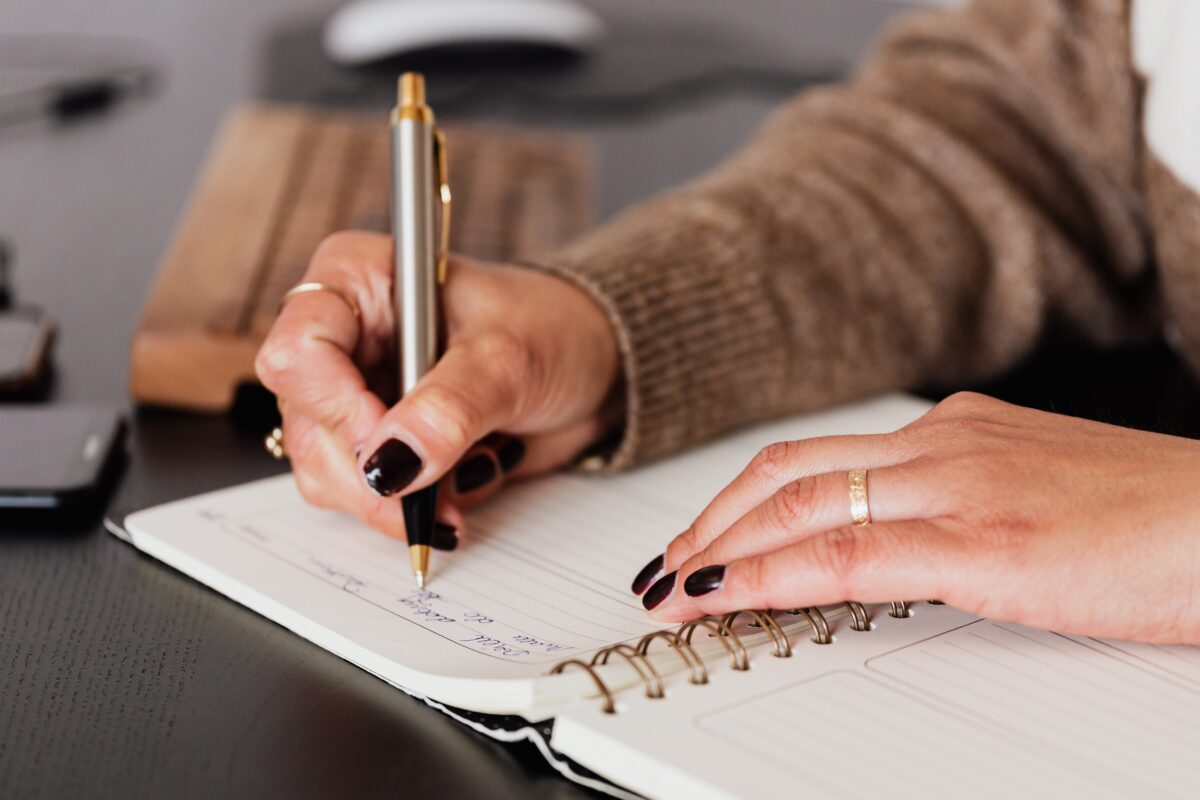Mindfulness journaling is a powerful tool to increase self-awareness, reduce stress, and improve overall mental health. But how do you start?
Here are 25 prompts to help you get started with mindfulness journaling so you can develop this regular practice that will enrich your life – it’s easier than you think!
What is Mindfulness / Gratitude Journaling?
Mindfulness journaling is a practice that involves writing down one’s thoughts and feelings with a focus on being present and in the moment. It is a form of meditation that allows individuals to reflect on their experiences and become more aware of their thoughts and emotions.
Benefits of Mindfulness Journaling
Mindfulness journaling is a practice that combines elements of mindfulness and journaling. As such, it involves taking time to be present and aware of your thoughts, feelings, and sensations while writing them down in a journal.
Writing down your thoughts and emotions in a journal can help you:
- Process your feelings and emotions in a constructive manner
- Examine your thoughts and feelings with more clarity and objectivity – which leads to a better understanding of yourself and your emotions
- Boost creativity and problem-solving skills, as it encourages you to think more deeply and explore different perspectives
- Improve your mental health by enhancing self-awareness and reducing stress and anxiety
Furthermore, the act of mindfulness journaling can be therapeutic in itself. It can help individuals gain insight into their patterns of behavior and thought, identify negative behaviors or thought patterns, and develop healthier habits.
All these benefits can lead to a greater sense of self-awareness, emotional intelligence, and overall well-being.
How to Get Started with Gratitude Journaling
Mindfulness journaling can be an excellent way to cultivate awareness and clarity in your life. It involves regularly writing down your thoughts, feelings, and experiences with an open and non-judgmental attitude.
1. Get a journal
Before we even dive in, you’ll need a gratitude journal or a blank journal. We’ve used some awesome guided gratitude journals, and these can make for a great starting place. But if you feel you’re a journaling pro and ready to get started with a blank journal – go for it!
2. Find time and a place
To get started with mindfulness journaling, you first need to set aside some time each day for this practice. It could be as little as five minutes or as long as you’d like. Find a quiet and comfortable space where you can concentrate and be free from distractions.
3. Start writing freely (or use prompts)
Next, start by taking a few deep breaths and focus on the present moment. Begin writing whatever comes to mind, without worrying about grammar or spelling. Allow yourself to express your thoughts and emotions in a safe and non-judgmental space.
You may also want to experiment with different prompts, such as gratitude lists or reflections on your day. The important thing is to make a habit of journaling regularly and with intention.
4. Keep at it
Finally, remember to be patient with yourself and take it one day at a time. Mindfulness journaling is a long-term practice that can bring immense benefits, including reduced stress, improved self-awareness, and also, greater inner peace.
Some Practical Tips for Mindfulness Journaling
Mindfulness journaling is an effective way to deal with stress and anxiety. Here are some practical tips and instructions to help you get started:
1. Start with gratitude: Begin each entry by writing down three things you are grateful for. This will put you in a positive mindset and help center your thoughts.
2. Describe your emotions: Write down how you’re feeling and why. Be honest with yourself and don’t judge your emotions.
3. Reflect on your day: Review the events and interactions that occurred throughout the day. Be mindful of your reactions and responses.
4. Write down your goals: Write down your short-term and long-term goals. This will help you stay focused and motivated.
5. End with positive affirmations: Finish off each entry with positive affirmations. This will help you go to bed feeling calm and optimistic.
Editor’s Note: Remember, mindfulness journaling is a personal practice that should be done at your own pace. So, don’t be too hard on yourself and enjoy the process. Also, consistency will make the biggest difference and help you identify patterns and increase your self-awareness.
25 Helpful Mindfulness Journaling Prompts
Mindfulness journaling is a powerful self-care tool that can help individuals cultivate awareness, reduce stress and anxiety, and enhance their overall well-being. Here are some simple prompts to help you explore and reflect on different aspects of your life.
25 Mindfulness Journaling Prompts:
1. What are three things you are grateful for today?
2. How can you bring more kindness into your interactions with others?
3. What are some simple mindfulness practices you can incorporate into your day?
4. What are three things that are currently causing you stress or anxiety? How can you address or alleviate these concerns?
5. What are some positive affirmations you can use to support your well-being?
6. What are some qualities you admire in yourself? How can you cultivate these qualities further?
7. What are some self-care practices that you enjoy? How often can you incorporate them into your routine?
8. How can you cultivate a sense of ease and relaxation in your life?
9. What are some goals or aspirations you have for yourself? How can a mindfulness practice support you in achieving these goals?
10. What are some values or principles that are important to you? How can you express these values in your daily life?
11. How can you practice self-compassion and self-forgiveness?
12. What are some ways you can connect with nature to cultivate a sense of calm and grounding?
13. What are some things you can do to minimize distractions and cultivate focus in your daily life?
14. How can you incorporate mindfulness into your relationships and interactions with others?
15. What are some ways you can integrate physical movement or exercise into your mindfulness practice?
16. What are some things that make you feel happy and fulfilled? How can you prioritize these things in your life?
17. How can you cultivate a sense of curiosity and openness in your life?
18. What are some ways you can practice mindful breathing and relaxation techniques?
19. How can you become more aware of your thoughts and emotions without judgment?
20. What are some things you can do to cultivate a sense of balance in your life?
21. How can you practice being present in the moment?
22. What are some ways you can find joy and beauty in everyday life?
23. What are some ways you can practice compassion and understanding towards others?
24. How can you cultivate a sense of gratitude and appreciation for life?
25. What are some ways you can celebrate your accomplishments and milestones, no matter how small?
Also, check out our master list of journal prompts.
Get Started on Your Journaling Journey
Mindfulness and gratitude journaling are powerful tools that can help you to improve your mental health and overall wellbeing.
By focusing on the present moment, paying attention to your thoughts and feelings, and using prompts and tips to guide your writing, you can develop a stronger sense of self-awareness and mindfulness. So, whether you are just starting out or have been journaling for years, incorporating mindfulness techniques into your writing can be a transformative experience that allows you to live a more fulfilling life.
Go grab a pen and paper, and start exploring the many benefits of mindfulness journaling today!





